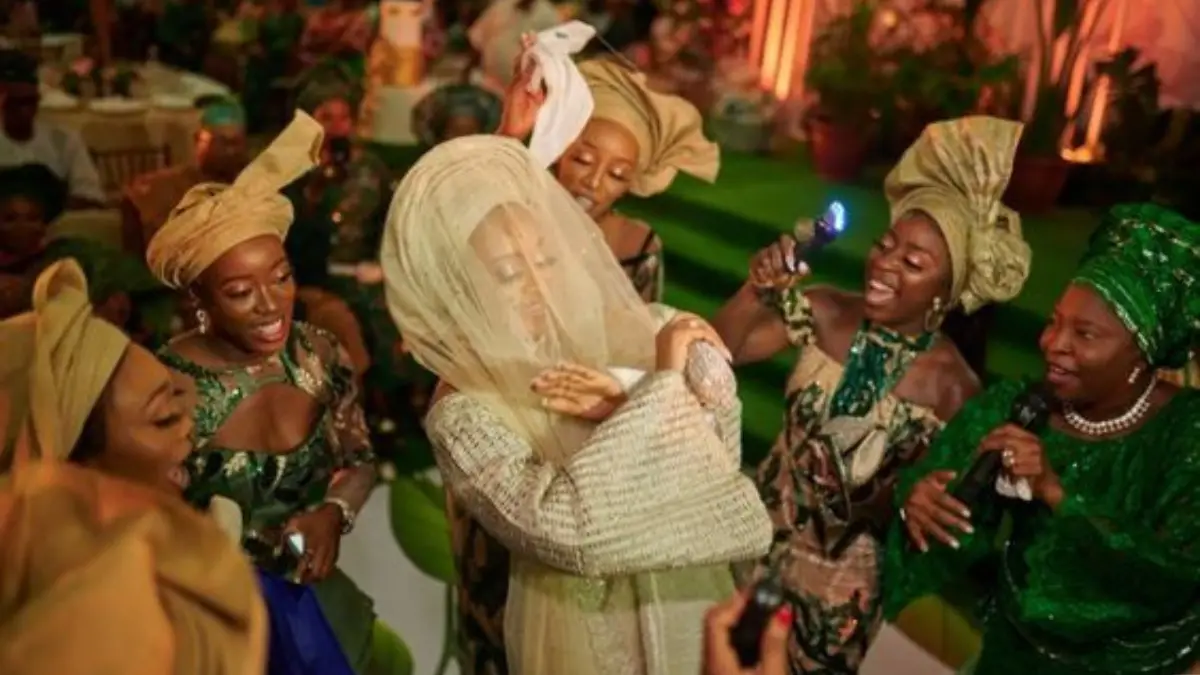Lights on. Upbeat music. Joyful colors. Delicious aroma. Naira notes raining. Happy feet trampling. This is the spectacle of the owambe in Yoruba culture, and it’s scarcely a sober affair, even when it’s a funeral. You can ask Wizkid. Unlike the popular misconception, owanbe in Yoruba culture isn’t all about the brilliantly colored aso ebi and sumptuous meals. You might have attended several parties, but it cannot be an Owambe party if it doesn’t have some or all of these elements:
● An Origin as Beautiful as the Culture
Owambe, as a word, originated from the 1960s Yorubas. According to a hilarious story, it all began with a Yoruba woman who never misses accessorizing with her Ilẹkẹ (waist beads) when attending a party. Also, at the time, it was the usual practice for Yoruba men to look out for women wearing Ilẹkẹ to dance with them. When the man feels the beads around the woman’s waist, he takes a glance in the direction of his fellow men, who would ask in unison, “Ṣowanbẹ?” (“Is it there?”) And you know what his response would be, “Owanbẹ.” (“It is there?”)
With time, the word, Owambe, became associated with Yoruba parties and other parts of the country soon ‘caught the virus.’
● What’s an Owambe in Yoruba Culture without Aso Ebi?
If you ever walk into a Yoruba party, and everyone is dressed in evening gowns and suits, find the quickest exit. Nothing captures the cheerful ‘unity’ that comes with owambes in Yoruba culture than the colorful uniform fabric family, close relatives, and friends choose to wear for the ceremony.
Aso Ebi which means ‘family clothes’ sets guests apart from each other. And these outfits could be anything from Ankara, Lace, Adire, to Aso-Oke. Buying the Aso Ebi often serves as the gate pass and a symbol of unity and acceptance. Even where there’s no chosen Aso Ebi, there’s always a chosen ‘Gele’ (headgear) for the ladies, ‘Fila’ (cap) for the men, or a color theme at least.
● Always an Infectious Groove Galore
The average Yoruba party is incomplete without music and dance. And a true owambe brings to life an infectious groove with live bands and DJs. Expect a blend of different genres of Nigerian music, from Afrobeats to highlife, Fuji and many hit songs that create an electrified atmosphere you can’t resist.
What follows is a bout of energetic dance dotted by competitive ‘money spraying,’ which signifies the climax of any Owambe party. So, get your cash bundles and mints ready because the Yorubas do not call Owambe ‘inawo’ (to spend money) for nothing.
● How Large is Your Appetite?
If you think you have a large appetite, the Yoruba owambe will fill you to the brim. Literally!. The parties are also testify to their varying delicacies. There’s no limit to what you can serve at a Yoruba party, even a first-class ‘Garri’ treat is not off the menu.
However, regardless of the kinds of cuisines available, it is incomplete without Jollof rice, amala, and pounded yam. Like the popular Nigerian party Jollof, amala and pounded yam have also attained ‘GOAT’ status, as they go with varieties of soups.
Overall, owambe in Yoruba culture comes with enough to eat and drink. You even get enough to take home as well.

● The Owambe Ambience is Always a Stylish Spectacle
An owambe without style ‘is not there.’ Pardon my wordplay. For an event that reportedly draws its name from ladies known for their accessories, expect nothing short of a stylish parade less than a stylish parade. From Aso Ebi to grand decorations and magical transformation of event spaces, the owambe ambience will always feed the eyes.
For the hosts, this is a perfect way to set the mood for the revelries to come. You can look forward to colourful fabrics, graceful flowers, inventive sitting arrangements and table decorations, plus, decorative visuals. These jointly create a flawless ambience for the festive activities.
● Every ‘i’ Dotted Every ‘t’ Crossed
The standard is always high. So, every owambe host takes their time to plan. Typically, a successful Owambe requires months of planning, even to the very least celebration. In cases where an owambe would span two to three dayswould hold for two to three days, like weddings, expect a lengthier period of planning.
The goal is that, regardless of how long the event holds, guests must be entertained to satisfaction and that includes the non-stop meals, music and other fun activities. Mostly, the guests leave the party satisfied, going home with enough souvenirs and juicy tales to tell about the event. Emphasis on juicy tales. The reward or pride of an owambe host is how long and how wide stories of their party spread.
● The ‘Mogbo Moya’
If at any point, you’re left wondering why anyone seem to be dancing a little extra without spraying money, taking too many souvenirs, or they never stop requesting food, they are probably a ‘Mogbo Moya’ (I heard and I stopped by).
The Mogbo Moya are uninvited guests and an interesting component of every Owambe. You mostly find them wearing contrasting outfits/colour codes, because they were neither invited nor close to the celebrants. They simply heard about the event somewhere somehow, and boom, they’re there! ! The more, the merrier; isn’t it?
In Closing
Apart from the thrills of an Owambe in Yoruba culture, you also get an opportunity to relax, network, socialize, and celebrate with others. Some might be family and friends, while others could be new acquaintances or love interests. So, come prepared!
Don’t forget to comment below if I missed out on any stand-out features of owambe parties, especially in Yoruba culture.







